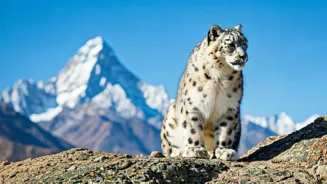Snow Leopard's Realm
The snow leopard, often called the 'ghost of the mountains,' is a captivating creature. Their elusive nature adds an element of mystery to the high-altitude
regions they inhabit. Primarily residing in the high-altitude regions of the Himalayas, these cats blend seamlessly with their surroundings due to their thick, smoky-gray fur. Their large paws act like snowshoes, allowing them to traverse the snowy terrain. These solitary animals are known for their agility and can leap incredibly long distances. Observing a snow leopard is a rare treat, making it a treasured experience for any traveler. Conservation efforts are crucial to protect their habitat and ensure their survival. The Himalayan environment provides the necessary rocky outcrops and caves to conceal these fascinating animals.
The Tibetan Wolf
Tibetan wolves are a unique subspecies of the gray wolf, perfectly adapted to the harsh Himalayan climate. They have thicker fur than their lowland counterparts, providing excellent insulation against the bitter cold. Found throughout the Tibetan Plateau and parts of the Himalayas, these wolves are opportunistic hunters, preying on various animals, including livestock. Their social structure is complex, typically living in packs that work together to hunt and raise their young. The Tibetan wolf's presence is essential to the Himalayan ecosystem, playing a critical role in balancing the wildlife population. Their resilience and adaptability make them a vital part of the region's fauna. While their interactions with humans can sometimes lead to conflict, they are a fascinating species to learn about and appreciate.
Red Panda's Habitat
The red panda is a small, arboreal mammal, easily identifiable by its reddish-brown fur and bushy tail. They are native to the Eastern Himalayas, and they inhabit high-altitude forests. These creatures are primarily herbivorous, feasting on bamboo, fruits, and occasionally eggs. They are known for their solitary nature, with the exception of the mating season. Conservation efforts are crucial, as their population faces challenges from habitat loss and fragmentation. Their distinctive appearance and gentle nature make them popular among wildlife enthusiasts. Witnessing a red panda gracefully moving through the trees is an unforgettable experience. Their presence adds to the beauty of the Himalayan forests.
The Himalayan Tahr
The Himalayan tahr is a large ungulate, known for its shaggy coat and curved horns. They inhabit the rocky slopes and cliffs of the Himalayas, thriving in the high-altitude environment. These animals are well-adapted to climbing steep terrains, utilizing their surefootedness to navigate challenging landscapes. They are herbivores, grazing on grasses and other vegetation. During the mating season, males engage in fierce competition for access to females, exhibiting impressive displays of strength. Their presence contributes to the balance of the Himalayan ecosystem, and they play a crucial role in maintaining the biodiversity of their habitats. Observing these animals in their natural habitat offers a glimpse of nature's beauty.
The Musk Deer
The Himalayan musk deer is known for the scent glands found in males, which produce musk, a valuable substance. They are medium-sized ungulates with long hind legs, enabling them to leap gracefully across rocky terrains. Inhabiting the dense forests and high-altitude areas of the Himalayas, they are primarily solitary animals. Their unique adaptation helps them navigate the challenging landscapes. The musk deer has become a focus of conservation efforts, as overhunting has threatened their populations. Witnessing these elusive creatures in their habitat is an enriching experience. Their presence enhances the ecological richness of the Himalayas.
The Tibetan Argali
The Tibetan argali is the largest wild sheep species. Known for its enormous, spiraling horns, they are an impressive sight. Living in the high-altitude grasslands and rocky terrains of the Himalayas, they are adapted to the harsh environment. Males engage in spectacular battles during the mating season, using their horns to compete for dominance. They are herbivores, grazing on various grasses and plants found in their habitat. Protecting the Tibetan argali is crucial for the preservation of biodiversity, as they are integral to the ecological balance of the Himalayan region. Spotting these magnificent creatures in their natural environment is an unforgettable experience, providing a sense of wonder.
Lammergeier's Soar
The lammergeier, also known as the bearded vulture, is a large bird of prey, easily identified by its distinct appearance. With a wingspan of up to 9 feet, these birds can soar gracefully over the mountains. They feed primarily on bones, which they drop from great heights to break them into smaller pieces. They inhabit the rocky and mountainous regions of the Himalayas, playing an important role as scavengers. Their presence contributes to the ecosystem's health, keeping the environment clear of carrion. Witnessing these birds circling high above is a breathtaking experience. Their unique diet and soaring abilities make them a fascinating species in the Himalayan environment.
Himalayan Monal's Beauty
The Himalayan monal is a vibrant pheasant, known for its iridescent plumage. The males showcase a mix of colors, while females have more muted tones. Inhabiting the high-altitude forests and rocky slopes of the Himalayas, these birds are a stunning sight. They feed on insects, seeds, and other vegetation, adding to their beauty and ecological importance. They are often considered symbols of beauty and pride. Seeing their elegant displays in the wild is a delight for any traveler. Their presence enhances the region's beauty, and they are a cherished species in the Himalayan environment.
The Blood Pheasant
The blood pheasant is a medium-sized bird known for its striking red and gray plumage. They are found in the higher reaches of the Himalayas. They inhabit the rocky slopes and forests of the region, where they forage for insects, seeds, and other food sources. Their adaptations allow them to withstand the cold temperatures of their habitat. These colorful birds are a joy to observe, adding to the vibrant beauty of the Himalayan landscape. They are a significant component of the local ecosystem. Spotting them in their natural habitat is a rewarding experience.
The Brown Bear
The Himalayan brown bear is a subspecies of the brown bear, uniquely adapted to the high-altitude environments of the Himalayas. With thick fur and powerful claws, they are built to withstand the challenging conditions. Found in the alpine meadows and forests of the region, they have an omnivorous diet, including plants, insects, and small animals. Protecting their habitat is crucial, as they are a vulnerable species threatened by habitat loss and climate change. Their presence is significant for maintaining the region's ecological balance. Witnessing these massive bears in their natural habitat provides a unique perspective on the beauty of nature.




